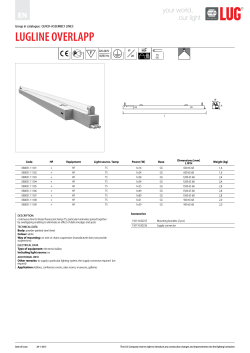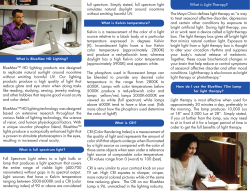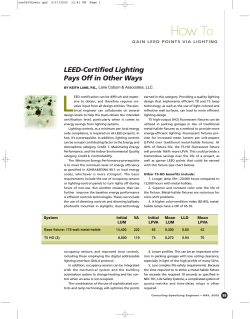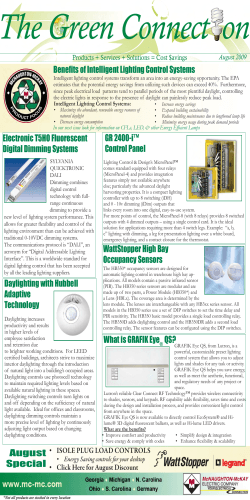
What is LM79 & LM80? Why are they important? Dr Gareth Jones
What is LM79 & LM80? Why are they important? Dr Gareth Jones CEO LUX-TSI & TheDoctor for LUX Magazine © 2012 LUX-TSI Limited www.lux-tsi.com Why do we need Standards for LEDs? • • • • Market is flooded with LEDs claiming to replace conventional lamps and luminaires Some achieve this, but many fall far short – LED lamps claiming to replace a 100W lamp may typically deliver less light than a 40W lamp! Limited market surveillance to identify these cases, and a lack of standards means they cannot easily act This is damaging consumer perception of LEDs in general – Negative impact on rate of LED acceptance – Avoid same bad feeling as early CFLs! © 2012 LUX-TSI Limited www.lux-tsi.com TheDoctor’s Mantra • I believe that the Americans have, in LM80 and LM79, developed effective and practical standards for testing of LED chip, lamp and luminaires. • These have been widely adopted in the US as de facto standards. • I believe European manufacturers should, in the absence of European standards with wide acceptance, adopt LM79 and LM80 until formal standards come into force in europe. © 2012 LUX-TSI Limited www.lux-tsi.com Disclaimer - European Standards • IEC/CEN is working on a revision to EN13032-1 but it is not clear when the new revision EN13032-x will come into force. • IESNA LM-79 and LM-80 have been in force since 2008 and are rapidly being adopted around the world for LED. • It is not that EN13032 is not good – it is that EN13032 does not cover LEDs yet and in the absence of this we advocate we should use LM-79-08 © 2012 LUX-TSI Limited www.lux-tsi.com • Accreditation is Important – Ensures a consistent minimum level of competence - independently audited and verified – Traceability of calibration so we avoid the “Chinese Lumen” problem • Round Robin Testing between Labs is Encouraged and is Important to ensure labs achieve consistency for Global Markets • Standards are Important – Ensure that all labs and manufacturers are given guidance on best practise. © 2012 LUX-TSI Limited www.lux-tsi.com Would you use a Cowboy builder? © 2012 LUX-TSI Limited I doubt it. You would look for some form of accreditation www.lux-tsi.com What to look for in Lighting Photometric Test Labs • Key global requirement for photometry & colorimetry is that testing laboratories have proven competence through ISO17025 audited by an ILAC affiliated organisations. • In the UK, this is UKAS. © 2012 LUX-TSI Limited www.lux-tsi.com Worldwide Lighting Test Laboratory Accreditation • IECEE CB Scheme for IEC Safety Approvals (iecee.org) • ILAC-MRA Bodies for Competence in Testing with ISO17025 (UK – ukas.com) • UL DAP Programme for submission of test reports against UL Standards ( ul.com) There are others but these are the main ones. © 2012 LUX-TSI Limited www.lux-tsi.com Types of Testing Electrical Performance Thermography EMC Emission & Immunity Safety Photometry Photobiological Form(Zhaga) Lumen Maintenance Endurance Labelling Environmental Mechanical © 2012 LUX-TSI Limited www.lux-tsi.com Types of Testing Electrical Performance Thermography EMC Emission & Immunity Safety Photometry Photobiological Form(Zhaga) Lumen Maintenance Endurance Labelling Environmental Mechanical © 2012 LUX-TSI Limited www.lux-tsi.com LM-79 “Electrical and Photometric Measurements of Solid-State Lighting Products” • IESNA Approved method describing procedures and precautions in performing reproducible measurements of SSL Products for Illumination Purposes: – Total Luminous Flux (lumens) – Luminaire Efficacy (lm/W) – Colour (Chromaticity, CCT, CRI) – Intensity Distribution Referenced to CIE, ANSI & IESNA © 2012 LUX-TSI Limited www.lux-tsi.com Lamps & Luminaires © 2012 LUX-TSI Limited www.lux-tsi.com Key Stipulations • Ultra stable Temperature +/- 1C • Voltage regulation < +/-0.2% • Thermal Stabilisation < 0.5% over 30 minutes • Test in Orientation of Use • Type C Goniometry only • Test Report minimum standard • Spectroradimetry preferred (photometer much less preferred but accepted if the spectral mismatch correction is provided – see TheDoctor – The Wheat & the Chaff) © 2012 LUX-TSI Limited www.lux-tsi.com Essential Items • Stable Power Source – Ensuring all changes in performance are due to the product. • Calibrated Power Meter – To measure the true power and calculate the power factor and harmonics • Calibrated Temperature Monitor 25C +/- 1C ! • Calibrated Air Flow Meter – No draughts! © 2012 LUX-TSI Limited www.lux-tsi.com Integrated Flux Integrating Sphere Spectroradiometer (or corrected Photometer) Calibration Lamps © 2012 LUX-TSI Limited www.lux-tsi.com Measure Spectral Flux with Wavelength • Compute – Total Integrated Flux (Lumens -Lm) – Colour Rendering Index (CRI) R1-R14 – Correlated Colour Temperature (CCT) – White Light Appearance – Tint (Duv) – Chromaticity (x,y u’,v’) – Luminous Efficacy (Lm / W) © 2012 LUX-TSI Limited www.lux-tsi.com Goniometric Intensity Type B Near-Field Imaging (not LM79 compliant) © 2012 LUX-TSI Limited Type C Far-Field Intensity (LM79 Compliant) www.lux-tsi.com Measure Intensity Distribution with Angle LED Without Optics © 2012 LUX-TSI Limited LED With Optics www.lux-tsi.com Measure Intensity with Angle Output key Plots and File Depending on Preference • • • • • • © 2012 LUX-TSI Limited • • • www.lux-tsi.com Thermal Stabilization ESSENTIAL FOR ALL LED MEASUREMENTS – KEY ISSUE • Ensure normal convection of air flow as to not affect the LED Temperature. • The effect of Temperature on LED performance is a key issue • Can give rise to errors as much as 30% in Luminous Flux • Can lead to big difference in CCT for colour mixed LEDs 3.00E-03 2.50E-03 Flux (W/nm) 2.00E-03 0 minutes 15 minutes 1.50E-03 30 minutes 45 minutes 1.00E-03 60 minutes 5.00E-04 0.00E+00 350 08/06/2011 © 2012 LUX-TSI Limited 400 450 500 550 600 650 700 750 800 850 Wavelength (nm) www.lux-tsi.com LM-80 “Approved method for measuring lumen depreciation of LED light sources” • “Light Sources” includes LED packages, arrays and modules. • Does not cover measurement of lamps and luminaires. Referenced to CIE, ANSI, LM79 standards © 2012 LUX-TSI Limited www.lux-tsi.com LM-80 “Approved method for measuring lumen depreciation of LED light sources” • Provides guidance for measuring lumen maintenance • Requires testing for at least 6000 hours at 3 different junction temperatures • Does not define or provide methods for estimation of life. • Requires TM-21 as the analysis method for determining the lumen maintenance value from the measurements. Referenced to CIE, ANSI & IESNA © 2012 LUX-TSI Limited www.lux-tsi.com LM-80 - Useful • Ensures lifetime of the LED is tested at component level – avoid the cost of testing of the final product assembly – this is a key design consideration! • Specifies 3 realistic temperatures for the testing – 2 are fixed and one can be determined by the manufacturer • Refers to LM79 for the basis of the testing of the photometric output of the sources - ensuring good practise (Did you spot the discrepancy?) • Is being used to prevent expensive 6000+ hour testing at the luminaire/lamp level • Is already referenced in UK schemes like ECA guidance © 2012 LUX-TSI Limited www.lux-tsi.com New Standard – LM82-12 - Characterization of LED Light Engines and LED Lamps for Electrical and Photometric Properties as a Function of Temperature. Excludes luminaires. © 2012 LUX-TSI Limited www.lux-tsi.com Some emerging Standards - IES LM-XX-12 Measuring Lumen Maintenance of LED Lamps, Light Engines and Luminaires - IES LM-XX-?? LED Package Reliability Testing – Qual/Overstress/Failure Specification & standardise on LED test specification for manufacturers - CIE TC2-71 Standard on Test Methods for LED Lamps, Luminaires and Modules - CIE TC 2-74 Gonio-spectroradiometry of Optical Radiation Sources - & others EN13032-?? © 2012 LUX-TSI Limited www.lux-tsi.com Quick Summary • Accreditation of test labs is important to ensure known minimum standards of competence, traceability and comparability around the world. • LM-79 and LM-80 good reference for test labs and manufacturers. Also, appearing in some Government incentive schemes. • Looking forward to EN13032 and other EN stds. • New standards from IESNA and CIE emerging fast to provide guidance on good practise for LED lighting. Adopt in the absence of better guidance. © 2012 LUX-TSI Limited www.lux-tsi.com Meet us at NEC Birmingham for UL/LUX-TSI Roadshow on LED Lighting Standards and Regulation 1-day free event 12th June (bit.ly/N2O74V) euroLED.org.uk 13th & 14th June Stand LED 218 © 2012 LUX-TSI Limited www.lux-tsi.com • UL/LUX-TSI Roadshow on LED Lighting Standards and Regulation 1-day free event 12th June (bit.ly/N2O74V) 10:00 - 10:15 Welcome and Introduction – SSL Global Trend Roberto Inclinati – Business Development Manager, UL • 10:15- 10:45 UL & IEC Standard update Albert van der Veen – Project Engineer, UL • 10:45 - 11:15 UL8750 for Decorative and Architectural LED Lighting Products to Access to the U.S Market with references to IEC requirements Albert van der Veen – Project Engineer, UL • 11:15 - 11.30 Coffee Break • 11:30 - 12:30 Energy Star & Lighting Facts- Legislation and Requirement for North America Gareth Jones – LUX-TSI Ltd. • 12:30 - 13.30 Buffet Lunch • 13:30 - 14:30 ErP - Legislation and Requirements for Europe Gareth Jones – LUX-TSI Ltd. • 14.30 - 15.30 Zhaga - Book 2 & Book 3 Luca Tibaldini – Engineering Manager © 2012 LUX-TSI Limited www.lux-tsi.com
© Copyright 2026





















